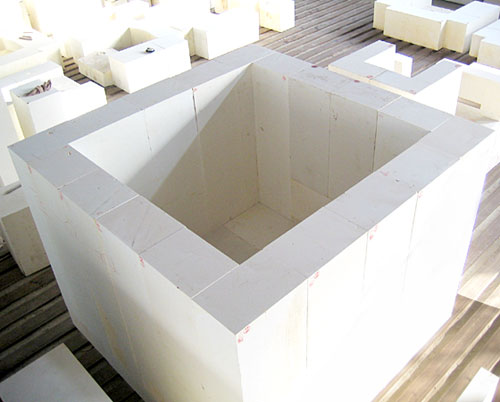
The entire furnace tank from melting tank, cooling tank until the molding part are all in contact with the glass liquid. The temperatures change from 1200 to 1600; during the whole process when the qualified glass is finished producing from material melting, and the glass liquid is in the convection state. So different parts of glass furnace need different refractory bricks.

7. regenerator chamber: top crown of regenerator usually adopts fused cast AZS brick, direct bonded magnesia brick or silica brick. The top layers of side wall and partition wall use magnesia brick, middle layers use magnesia brick or low porosity clay brick, and bottom layers adopt low porosity clay brick.
Physical chemical index:
Specification of AZS brick
AZS 33
AZS 36
AZS 41
Chemical
Al2O3
Remain
Remain
Remain
ZrO2
32-34%
35-37%
40-42%
SiO2
Less than 16.0%
Less than 14.0%
Less than 13.0%
Na2O
Less than 1.5%
Less than 1.6%
Less than 1.3%
Fe2O3+TiO2+CaO+MgO+Na2O+K2O+B2O3
Less than 2.5%
Less than 2.5%
Less than 2.5%
Bulk density (dense part)
3.85g/cm 3
3.95g/cm 3
4.0g/cm 3
Apparent porosity (dense part)
Less than 2.0.%
Less than 1.5.%
Less than 1.3.%
Anti-corrosion rate of glass liquid (soda-lime glass, 1500 Celsius 36h)
Less than 1.6mm/24h
Less than 1.5mm/24h
Less than 1.3mm/24h
Bubbling tendency (soda-lime glass, 1300 Celsius 10h)
Less than 2.0%
Less than 1.5%
Less than 1.0%
Exudation temperature of glass phase
More than 1400 Celsius
More than 1400 Celsius
More than 1400 Celsius
Volume
Normal casting and tilting casting (RC or TC)
3.4g/cm 3
3.45g/cm 3
3.55g/cm 3
End casting (EC)
3.6g/cm 3
3.7g/cm 3
3.8g/cm 3
Void free casting (VF)
3.8g/cm 3
3.9g/cm 3
3.95g/cm 3
analysis
weight



















